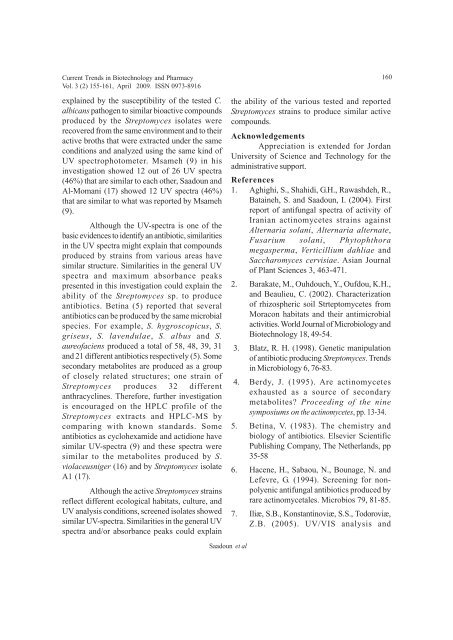April Journal-2009.p65 - Association of Biotechnology and Pharmacy
April Journal-2009.p65 - Association of Biotechnology and Pharmacy
April Journal-2009.p65 - Association of Biotechnology and Pharmacy
You also want an ePaper? Increase the reach of your titles
YUMPU automatically turns print PDFs into web optimized ePapers that Google loves.
Current Trends in <strong>Biotechnology</strong> <strong>and</strong> <strong>Pharmacy</strong><br />
Vol. 3 (2) 155-161, <strong>April</strong> 2009. ISSN 0973-8916<br />
explained by the susceptibility <strong>of</strong> the tested C.<br />
albicans pathogen to similar bioactive compounds<br />
produced by the Streptomyces isolates were<br />
recovered from the same environment <strong>and</strong> to their<br />
active broths that were extracted under the same<br />
conditions <strong>and</strong> analyzed using the same kind <strong>of</strong><br />
UV spectrophotometer. Msameh (9) in his<br />
investigation showed 12 out <strong>of</strong> 26 UV spectra<br />
(46%) that are similar to each other, Saadoun <strong>and</strong><br />
Al-Momani (17) showed 12 UV spectra (46%)<br />
that are similar to what was reported by Msameh<br />
(9).<br />
Although the UV-spectra is one <strong>of</strong> the<br />
basic evidences to identify an antibiotic, similarities<br />
in the UV spectra might explain that compounds<br />
produced by strains from various areas have<br />
similar structure. Similarities in the general UV<br />
spectra <strong>and</strong> maximum absorbance peaks<br />
presented in this investigation could explain the<br />
ability <strong>of</strong> the Streptomyces sp. to produce<br />
antibiotics. Betina (5) reported that several<br />
antibiotics can be produced by the same microbial<br />
species. For example, S. hygroscopicus, S.<br />
griseus, S. lavendulae, S. albus <strong>and</strong> S.<br />
aure<strong>of</strong>aciens produced a total <strong>of</strong> 58, 48, 39, 31<br />
<strong>and</strong> 21 different antibiotics respectively (5). Some<br />
secondary metabolites are produced as a group<br />
<strong>of</strong> closely related structures; one strain <strong>of</strong><br />
Streptomyces produces 32 different<br />
anthracyclines. Therefore, further investigation<br />
is encouraged on the HPLC pr<strong>of</strong>ile <strong>of</strong> the<br />
Streptomyces extracts <strong>and</strong> HPLC-MS by<br />
comparing with known st<strong>and</strong>ards. Some<br />
antibiotics as cyclohexamide <strong>and</strong> actidione have<br />
similar UV-spectra (9) <strong>and</strong> these spectra were<br />
similar to the metabolites produced by S.<br />
violaceusniger (16) <strong>and</strong> by Streptomyces isolate<br />
A1 (17).<br />
Although the active Streptomyces strains<br />
reflect different ecological habitats, culture, <strong>and</strong><br />
UV analysis conditions, screened isolates showed<br />
similar UV-spectra. Similarities in the general UV<br />
spectra <strong>and</strong>/or absorbance peaks could explain<br />
160<br />
the ability <strong>of</strong> the various tested <strong>and</strong> reported<br />
Streptomyces strains to produce similar active<br />
compounds.<br />
Acknowledgements<br />
Appreciation is extended for Jordan<br />
University <strong>of</strong> Science <strong>and</strong> Technology for the<br />
administrative support.<br />
References<br />
1. Aghighi, S., Shahidi, G.H., Rawashdeh, R.,<br />
Bataineh, S. <strong>and</strong> Saadoun, I. (2004). First<br />
report <strong>of</strong> antifungal spectra <strong>of</strong> activity <strong>of</strong><br />
Iranian actinomycetes strains against<br />
Alternaria solani, Alternaria alternate,<br />
Fusarium solani, Phytophthora<br />
megasperma, Verticillium dahliae <strong>and</strong><br />
Saccharomyces cervisiae. Asian <strong>Journal</strong><br />
<strong>of</strong> Plant Sciences 3, 463-471.<br />
2. Barakate, M., Ouhdouch, Y., Oufdou, K.H.,<br />
<strong>and</strong> Beaulieu, C. (2002). Characterization<br />
<strong>of</strong> rhizospheric soil Strteptomycetes from<br />
Moracon habitats <strong>and</strong> their antimicrobial<br />
activities. World <strong>Journal</strong> <strong>of</strong> Microbiology <strong>and</strong><br />
<strong>Biotechnology</strong> 18, 49-54.<br />
3. Blatz, R. H. (1998). Genetic manipulation<br />
<strong>of</strong> antibiotic producing Streptomyces. Trends<br />
in Microbiology 6, 76-83.<br />
4. Berdy, J. (1995). Are actinomycetes<br />
exhausted as a source <strong>of</strong> secondary<br />
metabolites Proceeding <strong>of</strong> the nine<br />
symposiums on the actinomycetes, pp. 13-34.<br />
5. Betina, V. (1983). The chemistry <strong>and</strong><br />
biology <strong>of</strong> antibiotics. Elsevier Scientific<br />
Publishing Company, The Netherl<strong>and</strong>s, pp<br />
35-58<br />
6. Hacene, H., Sabaou, N., Bounage, N. <strong>and</strong><br />
Lefevre, G. (1994). Screening for nonpolyenic<br />
antifungal antibiotics produced by<br />
rare actinomycetales. Microbios 79, 81-85.<br />
7. Iliæ, S.B., Konstantinoviæ, S.S., Todoroviæ,<br />
Z.B. (2005). UV/VIS analysis <strong>and</strong><br />
Saadoun et al













